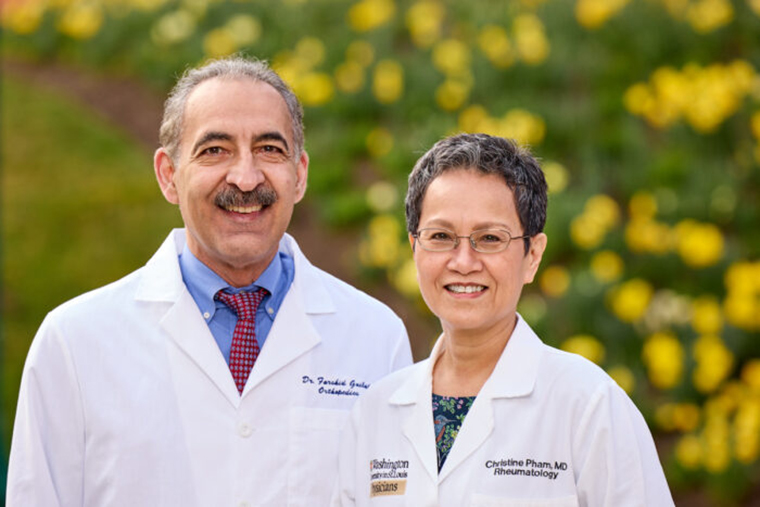
Osteoarthritis, a degenerative joint disease, limits the mobility of 32 million people nationwide, many to the point of significant disability. Affected individuals face limited options, as there are no drugs to cure or substantially lessen the disease, and invasive joint replacement is often the only option when it reaches its later stages.
With the goal of creating therapeutics that can help the body prevent or reverse the progression of osteoarthritis without surgical intervention, researchers at Washington University in St. Louis have received an award of up to $31 million from the Advanced Research Projects Agency for Health (ARPA-H). The agency, within the U.S. Department of Health and Human Services, was established in 2022 to improve the government's ability to accelerate biomedical and health solutions.
A multidisciplinary team led by scientists at the School of Medicine - and including faculty from the McKelvey School of Engineering and Arts & Sciences - aims to develop a single-injection treatment that promotes tissue regeneration and restores joints. The award falls under ARPA-H's NITRO program, for Novel Innovations for Tissue Regeneration in Osteoarthritis.
"Osteoarthritis has one of the greatest disease burdens of any disease in the world," said Farshid Guilak, PhD, the Mildred B. Simon Professor of Orthopaedic Surgery at Washington University and director of research at Shriners Children's St. Louis. "But we have no drugs that can reverse the joint damage it causes. This award is a moonshot initiative, funding high-risk projects with the goal of developing a single-injection treatment or even a cure for osteoarthritis. If successful, we could potentially affect the quality of life for millions of people and lessen the economic impact due to the billions of dollars spent treating pain caused by osteoarthritis."
Osteoarthritis occurs when cartilage - the protective cushion that sits between bones in a joint - wears down over time. Because cartilage absorbs the stress imposed by movement, its absence leads to stiffness and pain. Aging and wear and tear on joints over time contribute to the disease. However, youth is not necessarily protective. Joint injuries, genetics and obesity are risk factors.
"Sixty percent to 70% of young athletes with joint injuries will be affected by osteoarthritis 10 to 15 years down the road," said Christine T. N. Pham, MD, the Guy and Ella Mae Magness Professor of Medicine and director of the Division of Rheumatology within the university's Department of Medicine. "If we can reverse or stop the disease from progressing, we can save a lot of young individuals from undergoing joint-replacement surgery at an early age."
Osteoarthritis can develop over decades. By the time people go to their doctors to address the resulting pain, the loss of cartilage is irreversible. Treatment involves management of pain symptoms with over-the-counter medications and prescription opioids, which has contributed to the opioid crisis, Pham explained.
With the new award, Guilak and Pham will join with Washington University experts in nanomedicine, genetics, biomedical engineering and circadian biology to develop advanced nanoparticles intended to deliver snippets of genetic code into human joint cells and treat osteoarthritis with a single, yearly joint injection.
The project's other investigators are: Hua Pan, PhD, an associate professor of medicine; Xiaoxia Cui, PhD, an associate professor of genetics; Lori Setton, PhD, the Lucy and Stanley Lopata Distinguished Professor and chair of biomedical engineering at McKelvey Engineering; and biologist Erik Herzog, PhD, the Viktor Hamburger Distinguished Professor in Arts & Sciences.
Guilak previously developed genome-engineered cells called "SMART" cells that respond to environmental cues in the joint to produce biologic therapeutics. So, with the goal of transferring the technology to people, Guilak is teaming with Pham and Pan to engineer unique nanoparticles that can navigate to the joint tissue cells to insert genetic codes, to produce therapeutics in response to specific signals in the joint.
"We are putting knobs on the cells that will allow the body to self-tune drug production according to the severity of the inflammation, degree of mechanical load and the time of day," said Herzog, who previously collaborated with School of Medicine oncologists to show that chemotherapy used to treat glioblastoma patients worked better in the morning compared to the evening.
The university's Center of Regenerative Medicine, co-led by Guilak, the Genome Engineering & Stem Cell Center at the McDonnell Genome Institute, run by Cui, and the Department of Biomedical Engineering provide the critical infrastructure for developing the novel technology.
The team also will work with Andwele Jolly, DPT, of the St. Louis Integrated Health Network, and Matlock Jeffries, MD, of the Oklahoma Medical Research Foundation, toward ARPA-H's goals of providing equitable demographic representation in clinical trials and better understanding of barriers to health-care access for underrepresented populations.
"Our goal is to serve as a conduit for the voices of communities who have been historically marginalized and excluded from clinical trials," Jolly said.
About Washington University School of Medicine
WashU Medicine is a global leader in academic medicine, including biomedical research, patient care and educational programs with 2,900 faculty. Its National Institutes of Health (NIH) research funding portfolio is the second largest among U.S. medical schools and has grown 56% in the last seven years. Together with institutional investment, WashU Medicine commits well over $1 billion annually to basic and clinical research innovation and training. Its faculty practice is consistently within the top five in the country, with more than 1,900 faculty physicians practicing at 130 locations and who are also the medical staffs of Barnes-Jewish and St. Louis Children's hospitals of BJC HealthCare. WashU Medicine has a storied history in MD/PhD training, recently dedicated $100 million to scholarships and curriculum renewal for its medical students, and is home to top-notch training programs in every medical subspecialty as well as physical therapy, occupational therapy, and audiology and communications sciences.
Originally published on the School of Medicine website






